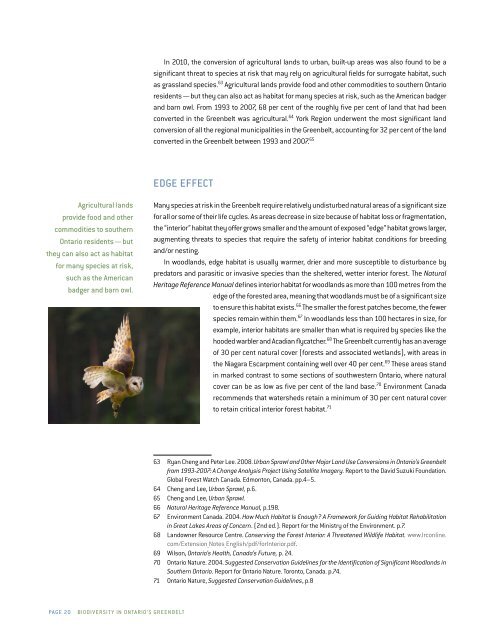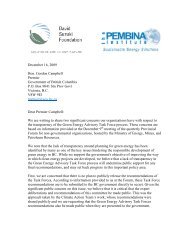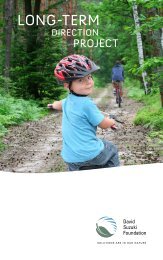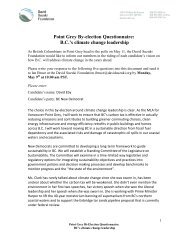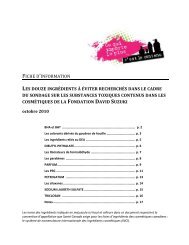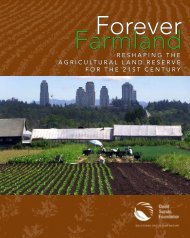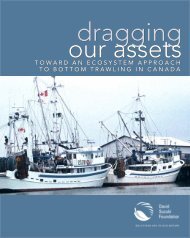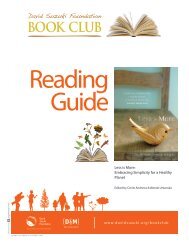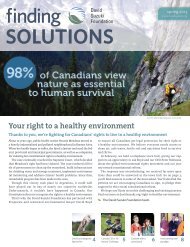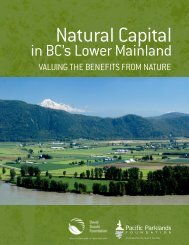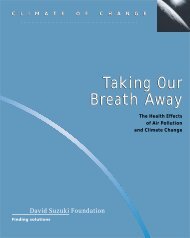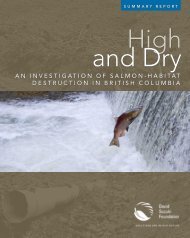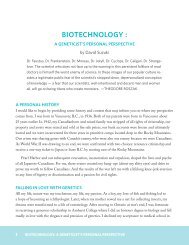Biodiversity in Ontario's Greenbelt (PDF) - David Suzuki Foundation
Biodiversity in Ontario's Greenbelt (PDF) - David Suzuki Foundation
Biodiversity in Ontario's Greenbelt (PDF) - David Suzuki Foundation
You also want an ePaper? Increase the reach of your titles
YUMPU automatically turns print PDFs into web optimized ePapers that Google loves.
In 2010, the conversion of agricultural lands to urban, built-up areas was also found to be a<br />
significant threat to species at risk that may rely on agricultural fields for surrogate habitat, such<br />
as grassland species. 63 Agricultural lands provide food and other commodities to southern Ontario<br />
residents — but they can also act as habitat for many species at risk, such as the American badger<br />
and barn owl. From 1993 to 2007, 68 per cent of the roughly five per cent of land that had been<br />
converted <strong>in</strong> the <strong>Greenbelt</strong> was agricultural. 64 York Region underwent the most significant land<br />
conversion of all the regional municipalities <strong>in</strong> the <strong>Greenbelt</strong>, account<strong>in</strong>g for 32 per cent of the land<br />
converted <strong>in</strong> the <strong>Greenbelt</strong> between 1993 and 2007. 65<br />
Edge effect<br />
Agricultural lands<br />
provide food and other<br />
commodities to southern<br />
Ontario residents — but<br />
they can also act as habitat<br />
for many species at risk,<br />
such as the American<br />
badger and barn owl.<br />
Many species at risk <strong>in</strong> the <strong>Greenbelt</strong> require relatively undisturbed natural areas of a significant size<br />
for all or some of their life cycles. As areas decrease <strong>in</strong> size because of habitat loss or fragmentation,<br />
the “<strong>in</strong>terior” habitat they offer grows smaller and the amount of exposed “edge” habitat grows larger,<br />
augment<strong>in</strong>g threats to species that require the safety of <strong>in</strong>terior habitat conditions for breed<strong>in</strong>g<br />
and/or nest<strong>in</strong>g.<br />
In woodlands, edge habitat is usually warmer, drier and more susceptible to disturbance by<br />
predators and parasitic or <strong>in</strong>vasive species than the sheltered, wetter <strong>in</strong>terior forest. The Natural<br />
Heritage Reference Manual def<strong>in</strong>es <strong>in</strong>terior habitat for woodlands as more than 100 metres from the<br />
edge of the forested area, mean<strong>in</strong>g that woodlands must be of a significant size<br />
to ensure this habitat exists. 66 The smaller the forest patches become, the fewer<br />
species rema<strong>in</strong> with<strong>in</strong> them. 67 In woodlands less than 100 hectares <strong>in</strong> size, for<br />
example, <strong>in</strong>terior habitats are smaller than what is required by species like the<br />
hooded warbler and Acadian flycatcher. 68 The <strong>Greenbelt</strong> currently has an average<br />
of 30 per cent natural cover (forests and associated wetlands), with areas <strong>in</strong><br />
the Niagara Escarpment conta<strong>in</strong><strong>in</strong>g well over 40 per cent. 69 These areas stand<br />
<strong>in</strong> marked contrast to some sections of southwestern Ontario, where natural<br />
cover can be as low as five per cent of the land base. 70 Environment Canada<br />
recommends that watersheds reta<strong>in</strong> a m<strong>in</strong>imum of 30 per cent natural cover<br />
to reta<strong>in</strong> critical <strong>in</strong>terior forest habitat. 71<br />
63 Ryan Cheng and Peter Lee. 2008. Urban Sprawl and Other Major Land Use Conversions <strong>in</strong> Ontario’s <strong>Greenbelt</strong><br />
from 1993-2007: A Change Analysis Project Us<strong>in</strong>g Satellite Imagery. Report to the <strong>David</strong> <strong>Suzuki</strong> <strong>Foundation</strong>.<br />
Global Forest Watch Canada. Edmonton, Canada. pp.4–5.<br />
64 Cheng and Lee, Urban Sprawl, p.6.<br />
65 Cheng and Lee, Urban Sprawl.<br />
66 Natural Heritage Reference Manual, p.198.<br />
67 Environment Canada. 2004. How Much Habitat Is Enough A Framework for Guid<strong>in</strong>g Habitat Rehabilitation<br />
<strong>in</strong> Great Lakes Areas of Concern. (2nd ed.). Report for the M<strong>in</strong>istry of the Environment. p.7.<br />
68 Landowner Resource Centre. Conserv<strong>in</strong>g the Forest Interior: A Threatened Wildlife Habitat. www.lrconl<strong>in</strong>e.<br />
com/Extension_Notes_English/pdf/forInterior.pdf.<br />
69 Wilson, Ontario’s Health, Canada’s Future, p. 24.<br />
70 Ontario Nature. 2004. Suggested Conservation Guidel<strong>in</strong>es for the Identification of Significant Woodlands <strong>in</strong><br />
Southern Ontario. Report for Ontario Nature. Toronto, Canada. p.74.<br />
71 Ontario Nature, Suggested Conservation Guidel<strong>in</strong>es, p.8<br />
Page 20<br />
<strong>Biodiversity</strong> <strong>in</strong> Ontario’s greenbelt


